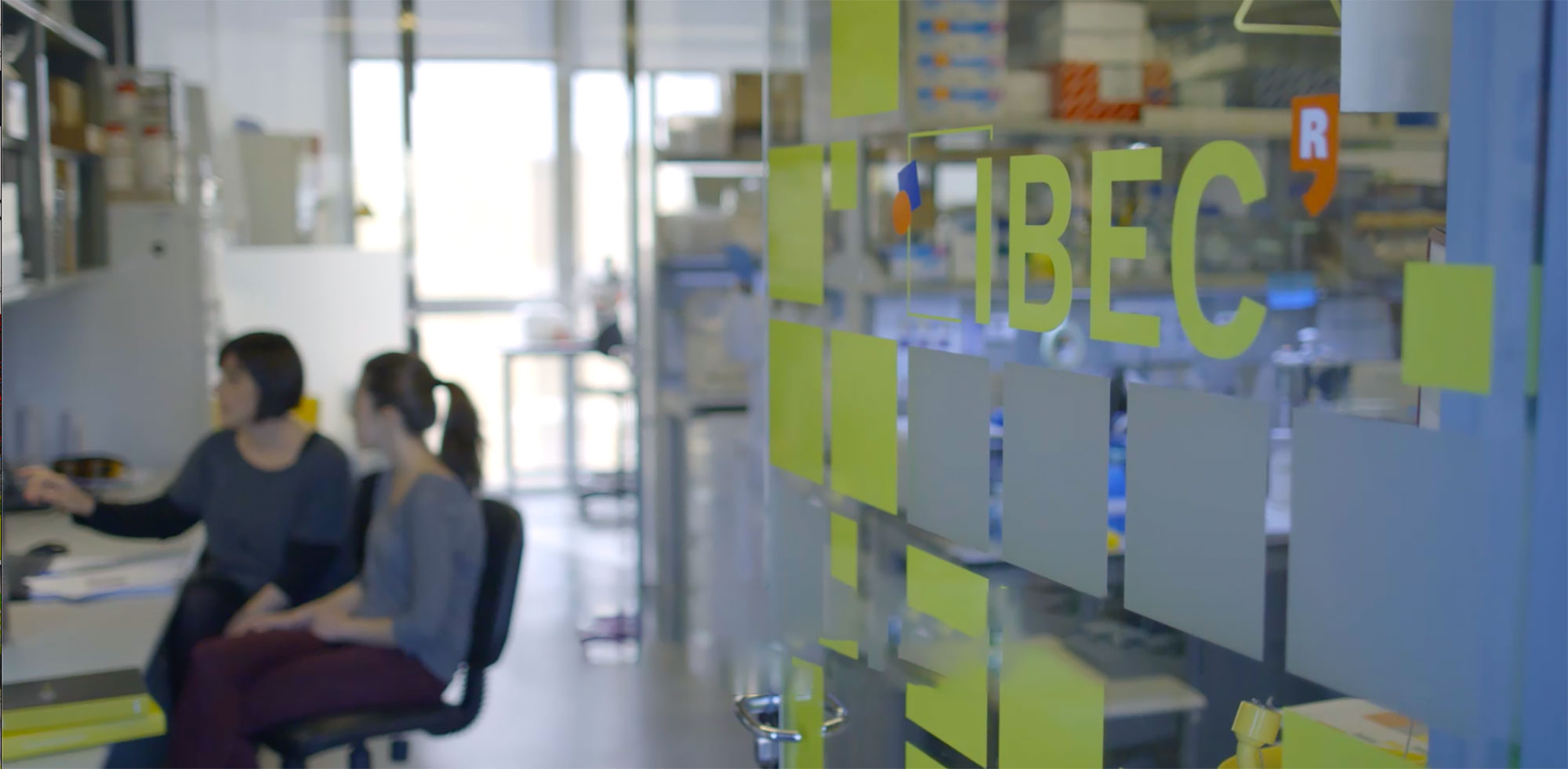Maria Teresa Galán Cascales
Microfab and Microscopy Characterization Facilities Coordinator
+34 934 037 138
tgalan

ibecbarcelona.eu
Staff member publications
 Perucca, Alice, Llonin, Andrea Gomez, Benach, Oriol Mane, Hallopeau, Clement, Rivas, Elisa I, Linares, Jenniffer, Garrido, Marta, Sallent-Aragay, Anna, Golde, Tom, Colombelli, Julien, Dalaka, Eleni, Linacero, Judith, Cazorla, Marina, Galan, Teresa, Pastor Viel, Jordi, Badenas, Xavier, Recort-Bascuas, Alba, Comerma, Laura, Fernandez-Nogueira, Patricia, Rovira, Ana, Roca-Cusachs, Pere, Albanell, Joan, Trepat, Xavier, Calon, Alexandre, Labernadie, Anna, (2025). Micro Immune Response On-chip (MIRO) models the tumour-stroma interface for immunotherapy testing Nature Communications 16, 1279
Perucca, Alice, Llonin, Andrea Gomez, Benach, Oriol Mane, Hallopeau, Clement, Rivas, Elisa I, Linares, Jenniffer, Garrido, Marta, Sallent-Aragay, Anna, Golde, Tom, Colombelli, Julien, Dalaka, Eleni, Linacero, Judith, Cazorla, Marina, Galan, Teresa, Pastor Viel, Jordi, Badenas, Xavier, Recort-Bascuas, Alba, Comerma, Laura, Fernandez-Nogueira, Patricia, Rovira, Ana, Roca-Cusachs, Pere, Albanell, Joan, Trepat, Xavier, Calon, Alexandre, Labernadie, Anna, (2025). Micro Immune Response On-chip (MIRO) models the tumour-stroma interface for immunotherapy testing Nature Communications 16, 1279 
Immunotherapies are beneficial for a considerable proportion of cancer patients, but ineffective in others. In vitro modelling of the complex interactions between cancer cells and their microenvironment could provide a path to understanding immune therapy sensitivity and resistance. Here we develop MIRO, a fully humanised in vitro platform to model the spatial organisation of the tumour/stroma interface and its interaction with immune cells. We find that stromal barriers are associated with immune exclusion and protect cancer cells from antibody-dependent cellular cytotoxicity, elicited by targeted therapy. We demonstrate that IL2-driven immunomodulation increases immune cell velocity and spreading to overcome stromal immunosuppression and restores anti-cancer response in refractory tumours. Collectively, our study underscores the translational value of MIRO as a powerful tool for exploring how the spatial organisation of the tumour microenvironment shapes the immune landscape and influences the responses to immunomodulating therapies.
JTD Keywords: Activation, Animals, Architecture, Breast-cancer, Cancer-associated fibroblasts, Cell line, tumor, Collagen, Female, Humans, Immunomodulation, Immunotherapy, Interleukin-2, Lab-on-a-chip devices, Mechanism, Mice, Microenvironment, Migration, Neoplasms, Stromal cells, T-cells, Therap, Tumor microenvironment
 Zaffino, R. L., Galan, T., Pardo, W. A., Mir, M., Samitier, J., (2015). Nanoprobes for enhanced electrochemical DNA sensors Wiley Interdisciplinary Reviews: Nanomedicine and Nanobiotechnology 7, (6), 817-827
Zaffino, R. L., Galan, T., Pardo, W. A., Mir, M., Samitier, J., (2015). Nanoprobes for enhanced electrochemical DNA sensors Wiley Interdisciplinary Reviews: Nanomedicine and Nanobiotechnology 7, (6), 817-827
Biosensors, small devices enabling selective bioanalysis because of properly assembled biological recognition molecules, represent the fortuitous results of years of interdisciplinary and complementary investigations in different fields of science. The ultimate role of a biosensor is to provide coupling between the recognition element and the analyte of interest, bringing a quantitative value of its concentrations into a complex sample matrix. They offer many advantages. Among them, portability, low cost with fast response times, and the possibility to operate in situ without the need for sample preparation are certainly the most important. Among biosensors, a large space is occupied by DNA biosensors. Screening genomic DNA is of fundamental importance for the development of new tools available to physicians during the clinical process. Sequencing of individual human genomes, accomplished principally by microarrays with optical detection, is complex and expensive for current clinical protocols. Efforts in research are focused on simplifying and reducing the cost of DNA biosensors. For this purpose, other transduction techniques are under study to make more portable and affordable DNA biosensors. Compared with traditional optical detection tools, electrochemical methods allow the same sensitivity and specificity but are less expensive and less labor intensive. Scalability of electrochemical devices makes it possible to use the advantages introduced by nanosized components. The involvement of nanomaterials and nanostructures with custom-tailored shapes and properties is expected to rapidly boost the field of electrochemical DNA biosensors and, in general, that of next-generation sequencing technologies.
JTD
 Galan, Teresa, Lagunas, Anna, Martinez, Elena, Samitier, Josep, (2015). Fabrication of bioactive polypyrrole microelectrodes on insulating surfaces by surface-guided biocatalytical polymerization RSC Advances 5, (82), 67082-67088
Galan, Teresa, Lagunas, Anna, Martinez, Elena, Samitier, Josep, (2015). Fabrication of bioactive polypyrrole microelectrodes on insulating surfaces by surface-guided biocatalytical polymerization RSC Advances 5, (82), 67082-67088
Although promising, organic microelectronics lacks standard fabrication methods comparable to photolithography in terms of resolution. Here we propose a novel and easily scalable on-surface biocatalytical procedure for the fabrication of polypyrrole microelectrodes on insulating surfaces. Arrays of polypyrrole microelectrodes were obtained by surface-guided biocatalytical polymerization, achieving up to 5 [small micro]m in resolution and conductivities up to 3 S cm-1. The mild reaction conditions provided by the biocatalytical approach permit the entrapment of bioactive compounds during polymer synthesis. This system is convenient for drug release purposes, as demonstrated by the controlled release of entrapped biotin through electrical stimulation. These results pave the way for the application of polypyrrole microelectrodes produced through biocatalysis in the development of implantable devices for remotely controlled tissue interactions.
JTD
![]() Perucca, Alice, Llonin, Andrea Gomez, Benach, Oriol Mane, Hallopeau, Clement, Rivas, Elisa I, Linares, Jenniffer, Garrido, Marta, Sallent-Aragay, Anna, Golde, Tom, Colombelli, Julien, Dalaka, Eleni, Linacero, Judith, Cazorla, Marina, Galan, Teresa, Pastor Viel, Jordi, Badenas, Xavier, Recort-Bascuas, Alba, Comerma, Laura, Fernandez-Nogueira, Patricia, Rovira, Ana, Roca-Cusachs, Pere, Albanell, Joan, Trepat, Xavier, Calon, Alexandre, Labernadie, Anna, (2025). Micro Immune Response On-chip (MIRO) models the tumour-stroma interface for immunotherapy testing Nature Communications 16, 1279
Perucca, Alice, Llonin, Andrea Gomez, Benach, Oriol Mane, Hallopeau, Clement, Rivas, Elisa I, Linares, Jenniffer, Garrido, Marta, Sallent-Aragay, Anna, Golde, Tom, Colombelli, Julien, Dalaka, Eleni, Linacero, Judith, Cazorla, Marina, Galan, Teresa, Pastor Viel, Jordi, Badenas, Xavier, Recort-Bascuas, Alba, Comerma, Laura, Fernandez-Nogueira, Patricia, Rovira, Ana, Roca-Cusachs, Pere, Albanell, Joan, Trepat, Xavier, Calon, Alexandre, Labernadie, Anna, (2025). Micro Immune Response On-chip (MIRO) models the tumour-stroma interface for immunotherapy testing Nature Communications 16, 1279 ![]()
![]() Zaffino, R. L., Galan, T., Pardo, W. A., Mir, M., Samitier, J., (2015). Nanoprobes for enhanced electrochemical DNA sensors Wiley Interdisciplinary Reviews: Nanomedicine and Nanobiotechnology 7, (6), 817-827
Zaffino, R. L., Galan, T., Pardo, W. A., Mir, M., Samitier, J., (2015). Nanoprobes for enhanced electrochemical DNA sensors Wiley Interdisciplinary Reviews: Nanomedicine and Nanobiotechnology 7, (6), 817-827![]() Galan, Teresa, Lagunas, Anna, Martinez, Elena, Samitier, Josep, (2015). Fabrication of bioactive polypyrrole microelectrodes on insulating surfaces by surface-guided biocatalytical polymerization RSC Advances 5, (82), 67082-67088
Galan, Teresa, Lagunas, Anna, Martinez, Elena, Samitier, Josep, (2015). Fabrication of bioactive polypyrrole microelectrodes on insulating surfaces by surface-guided biocatalytical polymerization RSC Advances 5, (82), 67082-67088

 ibecbarcelona.eu
ibecbarcelona.eu